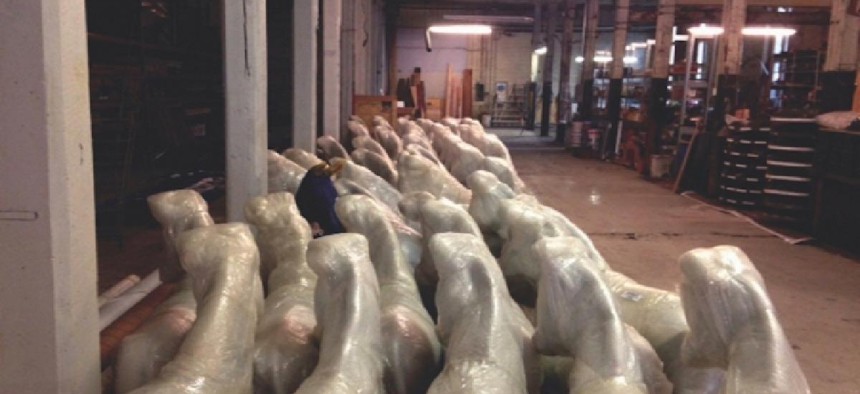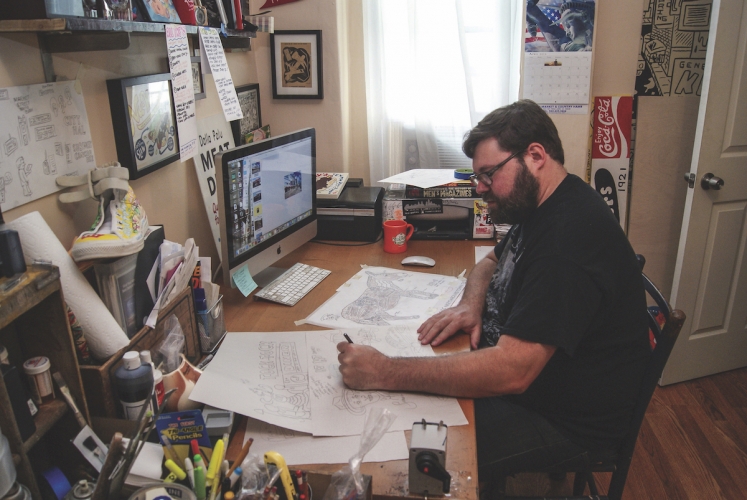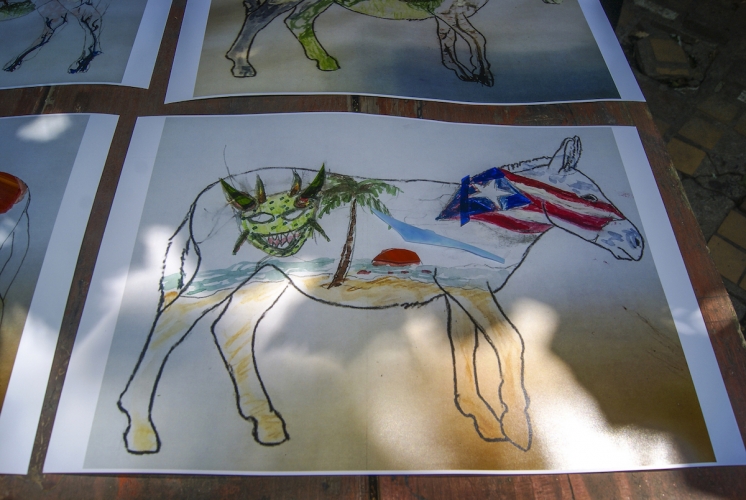Philadelphia
Donkey statues invade Philly ahead of DNC

Fiberglas donkeys await delivery to their artists in a warehouse. Photo by Dave Heit
The images that best represent Pennsylvania’s neighbor across the Delaware River? According to New Jersey Democrats, most of the Garden State’s icons are human or human-made: the Atlantic City skyline, Frank Sinatra, the Tick Tock Diner and the Lower Trenton bridge, which bears the motto “Trenton Makes/The World Takes.” Not a single garden among them.
Meanwhile, the Democrats of Maine are all about the natural world, wanting to be best known for Mount Katahdin, wild blueberries, the state mammal (moose) and the newly chosen state crustacean (lobster, melted butter optional).
These unique insights into state Party psyches come courtesy of the Philadelphia 2016 Host Committee for the Democratic National Convention’s Donkeys Around Town program. On July 1, a total of 57 decorated donkey statues – one for each state, the five U.S. territories, Washington, D.C., and a single statue representing Democrats living in other countries – will take their place throughout downtown, ready to welcome the DNC’s 6,000 delegates and more than 40,000 other visitors, including journalists and tourists, as part of the July 25-28 convention. Each statue is designed based on a list of suggested images submitted by the delegation it represents.
The public art project is meant to generate excitement about the convention, to showcase 30 local artists and the city's Mural Arts Program, and to encourage newcomers to explore the neighborhoods beyond the city’s historic core, said Angela Val, deputy executive director of the Philadelphia Host Committee.
“This is a chance to showcase that Philadelphia is more than cheesesteaks, the Liberty Bell and the Rocky steps,” Val said. “It shows Philadelphia is a fun place and people here have a great time.”
And what could say “fun” more clearly than a crowd of adults chanting “hee-haw, hee-haw,” as they did in April, when former Pennsylvania Gov. Ed Rendell, the Host Committee chairman, announced the new program during a press conference? Rendell said the parade was largely his idea, inspired by similar public art programs and a smaller-scale project for the Republican National Convention in 2000, which placed painted Liberty Bell replicas in the Pennsylvania Convention Center.
Rendell also unveiled the Pennsylvania donkey that day, the first one to be completed. The royal blue burro with yellow ears bears images of the Liberty Bell, the state flag and the Keystone State's official bird (the ruffed grouse) and flower (the mountain laurel). It will stand in the lobby of the Doubletree Hotel, where the state’s delegates are scheduled to stay.
The project’s $250,000 cost – financed by the largely corporate and private donations to the Host Committee – includes the statues, maintenance and the $1,000 stipend given to each artist for taking part in the project.
After the convention, each delegation can opt to take its donkey home – if it covers the shipping and handling charges, which will range from $200 to $2,000. Any remaining donkeys will be sold at auction, with proceeds going to the project’s artists.

Hawk Krall, working in his home studio – photo by Joseph Kemp
Illustrator Hawk Krall, who is designing the donkeys for New Jersey and New Hampshire, said while the pay wasn’t great, he was excited by the idea of producing art “that is actually out in the world … It’s going to be amazing to walk down the street and say, ‘Oh, there’s my donkey.’”
Krall, who lives in Philadelphia and once drew comic books, favors line-based illustrations in bright colors. That’s why he was excited by the New Jersey icon options presented to him. He’s imagining diner colors on one quarter, perhaps a boardwalk scene in traditional amusement park colors elsewhere. There’s only one element where he’ll have to be careful: The Atlantic City skyline. Donald Trump, the presumptive Republican presidential nominee, still has his name on a casino there.
“Obviously, I don’t want to endorse the competition,” he said.
He’s actually lucky. At one point, the Trump moniker adorned three Atlantic City casinos. He lost control of most of them after four corporate bankruptcies.
Using statues for community engagement isn’t a unique idea. In 1999, Chicago hosted the first U.S. CowParade, placing 300 Fiberglas bovines decorated by local artists throughout the Windy City. Since then, the American company, CowParade Holdings Corporation, has staged similar events in 79 cities worldwide. The statues are kept on display for two to four months and are then put up for auction. A portion of the proceeds is given to local charities; according to the company, more than $30 million has been given away in this manner.
Dozens of cities and counties have followed the CowParade model to create similar engagement efforts. In Juneau, Alaska, for example, artists painted whales. Sharks were on display in San Jose, Calif. Toledo, Ohio – once known as “Frogtown” because of its swampy beginnings – promoted itself with four-foot tall Fiberglas frogs.
In 2015, Visit Philadelphia, the region’s official tourism marketing agency, unveiled three statues meant to inspire photos: a three-person bike at LOVE Park, and two large sets of “XOXO” letters at Independence Visitor Center and 30th Street Station. The agency hoped people would take photos with the statues and then share them on social media, preferably with the hashtag #VisitPhilly, essentially turning visitors into de facto brand ambassadors promoting the city as a tourism destination.
The campaign was wildly successful. Between June 1 and Sept. 30, #VisitPhilly was used more than 48,000 times, mostly on Instagram. Compare that to 2014, when the hashtag was used about 21,000 times during the same time period. Instead of being removed as planned, the three statues will remain indefinitely.
The organizers of Donkeys Around Town hope this program has the same positive impact. Maps showing each donkey’s location will be available online as well as at tourism centers and hotels. A companion app will include a scavenger hunt during convention week with prizes available. The statues will be placed between the Delaware and Schuylkill Rivers and between Spring Garden Street in the north and the Navy Yard to the south.
“They’ll be indoors and outdoors, but never in a place where you have to buy a ticket or show I.D. to enter,” Val said. “We want people to be able to go in and take photos and then share them.”
There will even be a donkey on display outside the Union League. The organization, founded in 1862 to support the policies of Abraham Lincoln – a Republican – is hosting an exhibit for the event. That delighted Rendell, who, during a May press conference, praised the Union League’s leaders for this show of civic pride and unity.
“There may be some past presidents of the Union League, there may be some past presidents of the U.S., rolling over in their graves, but the Union League will take a donkey,” Rendell said.
It’s unclear if Rendell heard what one of the Union League’s representatives muttered in return: “We didn’t say what we would do with it.”
Perhaps this is a good place to explain how the Democrats came to have the stubborn working animal as their symbol.
Andrew Jackson was the first Democrat to use the donkey as a symbol when he was a presidential candidate in 1828. His opponents called him a “jackass,” so Jackson decided to take the intended slur as a compliment, saying it meant he was steadfast and determined. He went on to beat incumbent John Quincy Adams in the election and became the country’s first Democratic president.
The influential Harper’s cartoonist Thomas Nast used the donkey to represent the Democrats about 50 years later. The connection stuck. Nast was also the first person to depict Republicans as elephants, thus creating another icon. A 2012 Smithsonian magazine article on the icons suggests Nast was inspired by the phrase, “seeing the elephant,” used at that time to mean gaining an experience at a high cost.
Republicans maintain the elephant represents strength and dignity. Democrats today say the donkey is smart and brave. During the April project announcement, Pennsylvania Democratic Chairman Marcel L. Groen described the mascot as stable: “The donkey is not flashy. The donkey happens to be a very down-to-earth animal."
Not exactly fun, but do we really want a fun person to lead our nation?

Ellen Tiberino's concept for the Puerto Rico donkey includes a traditional veigante mask and the island's flag – photo by Joseph Kemp
David Heit, account manager for Roe Fabricators in Chester, said his company has never been asked to create an elephant statue but was fortunate to have a Fiberglas donkey already designed and on-hand when the Host Committee expressed interest in an order. (Roe also created the XOXO letters and the three-seat bicycle.)
“Ours was the superior design,” he said as a way of explaining what won the company the contract. “Up close, you can see the hairs of the donkey. Even the ears are proportionate.”
Each donkey is made of Fiberglas, weighs about 50 pounds and stands about four feet tall. The attached 200-pound steel base adds another 50 inches of height. Each statue will have an attached “Do not climb” sign and a painted border around the base intended to act as a barrier.
“It’s OK to put a baseball hat on a donkey, but don’t climb the donkey,” Val said.
Still, she and Heit predict that rule will be broken. To that end, the Host Committee has put together a team of “donkey doctors” – volunteers who will spot-check the statues and determine if repairs are needed. Businesses near the donkey statues have also agreed to monitor them.
“The ones that are outside in the elements – we’re not worried about the elements; we’re worried about the people,” Heit said. His past experience with Philadelphia statues has shown him that “people will take anything not nailed down. You wouldn’t believe it. From the bikes, people take the handle grips and the pedals.”
While there’s always the risk of damage to outdoor sculptures, artist Ellen Tiberino said the public aspect of the project is what drew her to it.
“People can interact with it – it’s not just something locked up in a museum,” she said. “It’s living art and it becomes more personal when you experience it one-on-one.”
Tiberino usually crafts mosaics, but her donkeys – representing Puerto Rico and Democrats Abroad – will be largely painted with mosaic highlights. Her Puerto Rico donkey features some of her favorite memories from a trip she made to the island a few years ago: the traditional vejigante mask reminds her of a family of artists she met in San Juan who have been creating these designs for generations; the beaches were an obvious choice, she said, describing the clear waters around Vieques; and the Puerto Rican flag has long been a symbol of pride and showcases the island’s distinctive personality.
“Democrats Abroad” will include icons like Niagara Falls – the Canadian side – as well as Mount Fuji and the Eiffel Tower. Tiberino, a lifelong Democrat, said she’s excited to finally bring her ideas to life on the donkey and is even more excited about the DNC being in her hometown.
“I want to welcome my fellow Democrats to my city and show them a good time,” she said. “I think we should make this a big party.”
